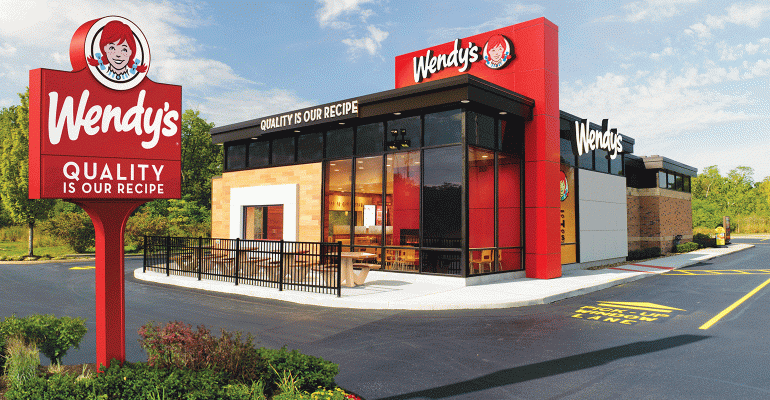Quick-service operator thinks small to grow bigger
To get bigger, The Wendy’s Co. is getting smaller.
The Dublin, Ohio-based burger chain wants to add another 1,000 locations by 2020, executives told investors on Thursday. One strategy the company plans to use to encourage that growth is a new, more flexible design that will enable Wendy’s to go into smaller spaces.
Traditionally, the quick-service chain needed at least an acre of real estate to build its traditional, standalone units. But its new “smart design” can go into much smaller spaces, said Abigail Pringle, Wendy’s chief development officer.
“The new designs enable the company to build on half an acre or even a quarter of an acre if needed,” Pringle said.
Wendy’s currently has just more than 6,500 locations worldwide. It wants to grow to 7,500 units by 2020. The locations would be both in North America, where the brand has commitments from operators to build at least 500 locations, and internationally
— where Wendy’s wants to grow from 439 locations now to 850 units.
Traditional sites are more difficult to open because real estate is more challenged today than it was a decade ago. One-acre sites in high-traffic areas don’t exactly grow on trees. And when they come along, they can be expensive.
The new design, executives said, is $300,000 cheaper than a traditional site.
That’s not the only strategy the company is using to expand add locations. Wendy’s is also adapting to urban areas.
“We are looking far beyond suburban markets,” Pringle said.
And the company is also looking at co-developing with convenience stores and other real estate opportunities, such as inline sites and strip-center end caps. And the company wants to convert vacated buildings — and not just restaurants.
One conversion opportunity, Pringle said, is banks.
“The real estate marketing is changing,” she said. “Banks are going less with bricks and mortar. And they already have a drive-thru.”
Wendy’s discussed its long-term strategy with investors on the same day it preannounced earnings for the fourth quarter ended Jan. 1. The company said same-store sales increased 0.8 percent in the quarter and 1.6 percent for the full year in North America.
Revenue in the quarter fell 33 percent, to $309.9 million, in the quarter, from $464.4 million, due to lost sales from the sale of restaurants to franchisees. Net income also fell, to $28.9 million, or 11 cents per share, from $85.9 million, or 31 cents per share.
Executives at the presentation said they want to increase profitability in addition to adding new locations. Some profitability will come from reductions in general and administrative spending. Wendy’s said it wants to cut another $35 million from G&A spending by 2020.
“We’re committed to accelerating savings,” Penegor said, although he noted that the company is currently developing plans to cut those costs.
Wendy’s said Thursday that it added 58 new restaurants worldwide in 2016.
“That was the highest global total since 2005,” Penegor said.
To get operators to build new locations, Wendy’s isn’t just using a smaller design. It’s also offering incentives.
In past years, Wendy’s would give operators building new units a 2-percent royalty abatement for the new unit for three years. Now the company will reduce costs by 5.5 percent in the first year the location is open, including a 2-percent royalty discount and a 3.5-percent ad fund discount
The abatement is reduced to 4 percent in the second year, including 1 percent on royalty payments and 3 percent on ad fund payments.
“This is about driving net new incremental growth,” Pringle said, noting that the company is leveraging its ad fund payments to drive growth. “After year two, there’s more money into the ad budget that was not there before.”
Wendy’s has also used its refranchising deals, and even franchisee-to-franchisee sales, to convince operators to add locations.
The chain has sold more than 1,000 locations to franchisees since 2013, following the sale of 537 locations in the third phase of that effort. Wendy’s has reduced its company-owned unit count from 1,427 locations in 2012, or 22 percent of the system, to 330 units now, or 5 percent.
The company has sold many of these locations to operators willing to build new locations.
“We wanted to focus on growth,” Wendy’s CEO Todd Penegor said. “We’re bringing in strong operators with strong balance sheets and with commitments to grow the system.”
Wendy’s also has a “buy-and-flip” strategy, in which it directs the transfer of franchisee-owned locations to preapproved operators willing to remodel locations and build new units.
“We are the ones playing matchmaker,” Pringle said. “We’re evaluating existing franchisees interested in leading the system. We want to work with them to find the right buyers.”
As part of these strategies, Wendy’s now has fewer, larger franchisees. In 2012, the company had 440 franchise companies. Today it has 375. The average size of a franchisee has increased from 11 locations to 15 units.
“Some larger franchise operators have used the opportunity to consolidate the market,” Penegor said. “They wanted to control pricing, advertising, they wanted to control development and they didn’t want to encroach on someone else. We have a healthier franchise community.”

